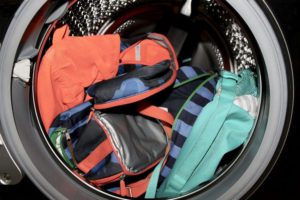 A huge number of people use backpacks, choosing them instead of uncomfortable bags and strict briefcases. Over time, each backpack becomes dirty, after which it needs to be sent to the wash. As such a need arises, the owner has a question: “Is it possible to wash a backpack in an automatic washing machine?”
A huge number of people use backpacks, choosing them instead of uncomfortable bags and strict briefcases. Over time, each backpack becomes dirty, after which it needs to be sent to the wash. As such a need arises, the owner has a question: “Is it possible to wash a backpack in an automatic washing machine?”
To prevent the product from becoming unusable due to these actions, all that remains is to find out whether washing is allowed for all materials, and then perform the correct actions.
Cleaning the backpack cavity

Before loading the product into the washing machine, it is checked for the presence of small things inside (coins, keys). Such measures are necessary to eliminate the negative impact on the machine and the thing itself. If there are coins inside, they can oxidize in an aqueous environment, which can cause stains and rust to appear on the fabric. If there are crumbs and other debris, they need to be shaken out or cleaned with a vacuum cleaner.
Preparation
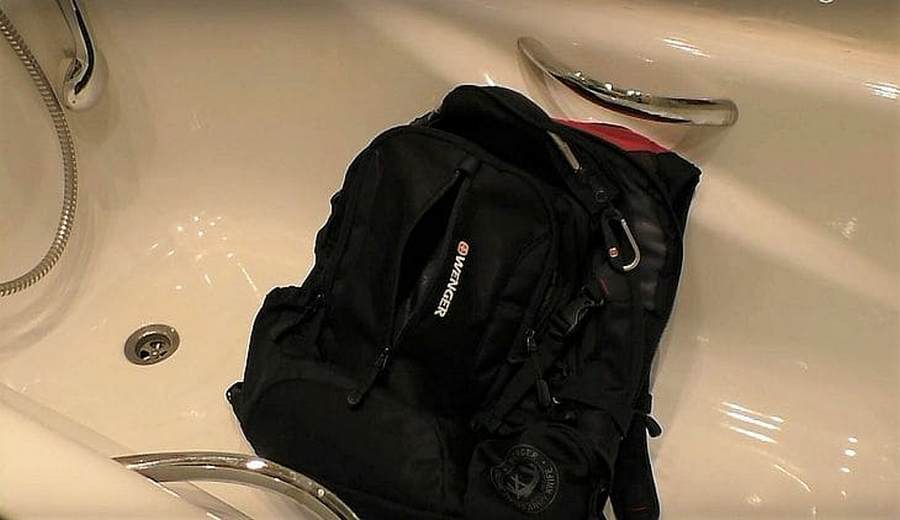
Hooks and straps can damage the washing machine, so they must be unfastened. Other hard elements of the product are removed. For the same reason, if possible, it is better to remove plastic carabiners and latches for manual cleaning.The protruding threads on pockets, zippers, and fastenings are cut off so that they do not spoil the item during processing by catching on other parts.
Before starting the device, each contaminated area is wiped with a wet cloth. Dried dirt can cause stains on your bag when exposed to water. If there are heavily soiled areas (stains), they are removed before washing. Before the procedure, you should treat the most contaminated areas with a stain remover or laundry soap, rub with a brush and rinse. The inside of the product may also contain stains (ink, drinks). In case of heavy contamination, the bag is soaked in warm water for an hour and a half. You just need to add soap (can be grated with shavings) and baking soda.
When machine washed, the pockets and snake sections wash much worse.
Studying the manufacturer's recommendations
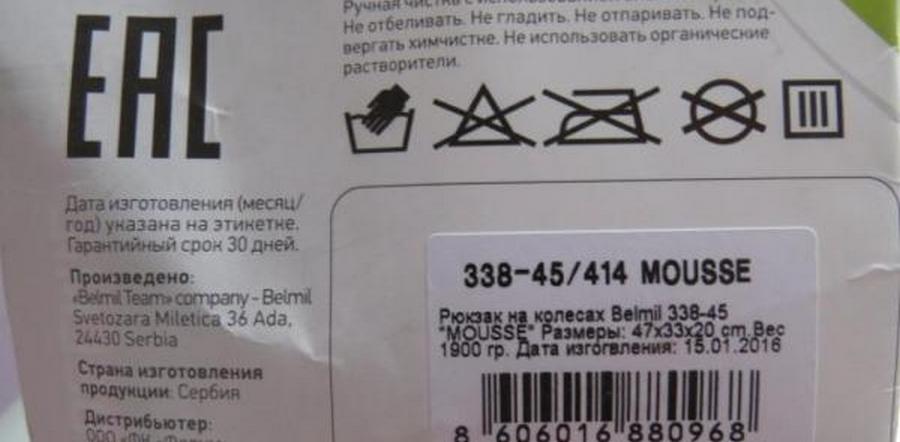
Any backpack must have a label from the manufacturer in the inner cavity. Almost always, this label contains information with instructions regarding washing, drying, ironing, which extends the life of the product and preserves its original appearance. The label is located in the side seam area. The explanation of the information on the label is available on the Internet; you just need to follow the recommendations.
It is important to remember that in the case of rough mechanical impact and aggressive processing mode, the structure of the fibers and the shape of the product loses its original properties. The water repellency function is impaired and the threads fray along the main seams. To prevent this, unauthorized choice of temperature and push-up strength is not recommended.It is unreasonable to expect a backpack to withstand elevated temperatures and twisting.
If there is no label with information on the bag, you should choose a gentle mode that does not exceed 400 rpm. Available for hand or delicate wash. Cleaning agents are selected as for delicate fabrics.
Instructions for washing the backpack
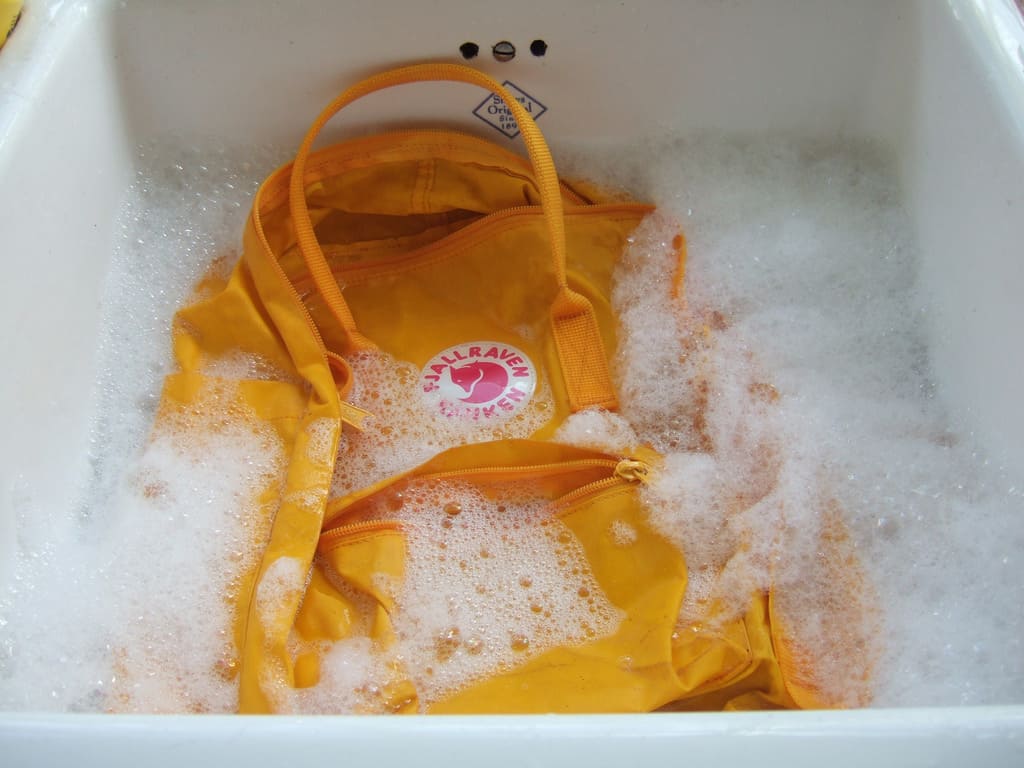
- You need to find the label on the backpack and follow the advice. If it is absent, you need to proceed to the next action.
- It is necessary to determine the material of manufacture of the product, most often it is tarpaulin or nylon, suitable for machine washing. If the material of manufacture is unknown, then you need to proceed to step No. 10.
- A backpack with several straps is washed in a special washing bag (large pillowcase) or it is turned inside out and all the straps are put inside. A bag or pillowcase is necessary so that the fasteners do not get stuck in the drum of the machine and do not damage its walls.
- Washing is performed in a gentle mode (gentle or delicate). For maximum protection of the backpack, only cold water should be used to prevent discoloration (up to 40 degrees).
- A safe powder is added and the machine is turned on. Due to the higher density of the fabric, rinsing is more difficult, so rinse aid may be required for colored items.
- The washing process must be controlled. When washing one backpack, the washing machine is unlikely to be able to balance it correctly. Then, in order to avoid distortion and imbalance in the internal compartment of the machine, the washing is paused and the correct position of the product is manually maintained so that it does not wrinkle.
- When the wash finishes, the item is removed.Remove excess water from the outside and inside with a dry cloth.
- If there is foam inside the item, dry it on a rope. A nylon item will dry quickly both in the sun and in the shade. If there is no foam or the backpack is canvas, you can use a dryer.
- A canvas item is dried on a low or medium setting in a dryer, which can take a long time.
- If machine washing does not work, use the manual mode. Place the item in a large container or bathtub.
- Rinse.
- Spin well.
- Dry as in step #8.
Recommendations and tips

You can find out how to properly wash a backpack with a machine by following these recommendations:
- If there is no label, information about the material can be found on the official website of the brand.
- Powder, liquid or gel-like agent is used for washing. Gel has a more gentle effect and is easier to rinse out of the fabric structure. There is a special type of washing powder used to wash camping gear. This product is not cheap, it has no smell, and does not contain disinfectants or additives.
- If you use a stain remover, it is better to test it on a small part of the inside of the item.
- When the wash is finished, it is better to immediately remove the item from the drum so that mold does not appear due to dampness.
- If the label contains information allowing the use of high temperatures, it is safer to maintain moderate temperatures to avoid deformation of the item and loss of color.
- Before the process, to assess the quality of the paint, you need to run a wet finger over the bag.If traces of dye remain, it is better to use a product with the most gentle effect and cool water. It is advisable not to wash the item with other items.
- If the backpack has a high cost, an exclusive model and you don’t want to take risks, then you can have it professionally dry-cleaned.
- In case of loss of water-repellent properties, shine, and appearance, which are often characteristic of nylon products, a special water-repellent spray is used on the fabric to restore the water-repellent effect.
Which backpacks are not machine washable?

Not every backpack can be machine washed. This option is not suitable for the following cases:
- Backpack with a solid frame (wooden, chipboard). Washing may cause loss of shape due to exposure to water. When using a plastic frame, stainless steel, or other moisture-resistant materials, it can be washed, but hard parts will need to be removed.
- For an orthopedic backpack, washing is not advisable because it is most likely equipped with a non-removable frame and has significant dimensions. There may not be enough space for the item in the drum, it may damage it or become deformed.
- Some backpacks have a water-repellent coating or other protective coating that prevents the penetration of water. Washing using powder will lead to a change or washing off of the composition, and the original properties will be lost.
- Leather products (as well as eco-leather items) cannot be washed. They can be wiped with a wet cloth. Contaminants are removed using a soap solution.
- If machine washing is not recommended by the manufacturer, this should be taken into account.
Machine washing is not allowed if the following is used to make the backpack:
- kondura - thickened nylon fabric made from a thread of a special structure, which has a water-repellent impregnation;
- Oxford is a synthetic material made from polyester;
- avisent - for the manufacture of the material, high-strength nylon thread using special weaving is used.
If the fabric is of unknown origin and there is no information about this on the label, then it is better not to machine wash it.
Keeping it clean for long-term use
If you frequently machine wash your backpack, it may harm it. To avoid washing too often, there are a few precautions you should take:
- do not collect various rubbish inside, empty pockets, send everything unnecessary directly to the trash bin;
- do not place the bag on the ground, you can hang it;
- keep the inside clean (for example, in school backpacks, shoes and other items can be wrapped in a bag);
- Pens, felt-tip pens, drinks, and other liquids may cause stains that are difficult to remove, so you should take care of additional packaging;
- Wet wipes will help remove fresh stains and dirt.
By following these tips you can significantly increase the life of your backpack.
Proper drying of a backpack
The natural drying method for a backpack is most suitable, and it is better with open pockets so that they dry better. If the conditions outside for drying are unsuitable (rain, winter), it is not recommended to dry it in a dryer. In the room itself, the conditions for this will be much better, and it’s worth leaving the backpack to dry at home.
Do not put your backpack in the closet until it is completely dry.Leaving wet areas of the fabric can cause mildew and an unpleasant odor that may not be easy to remove.
Conclusion
These tips will tell you how to machine wash your backpack. Recommendations will help maintain the item in good condition for a long time.








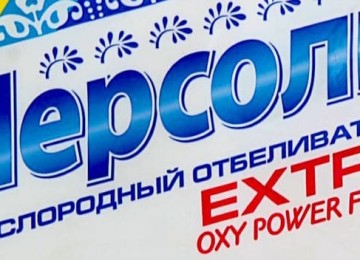
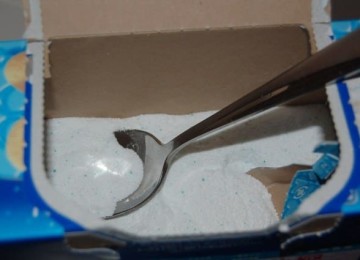
Read the information on the label. Almost all backpacks have a label with care instructions. As a rule, they indicate recommendations for washing and drying the backpack, so that the cleaning process does not impair resistance to external influences - for example, moisture resistance. The label is usually located inside the backpack, on the side seam in the largest compartment.